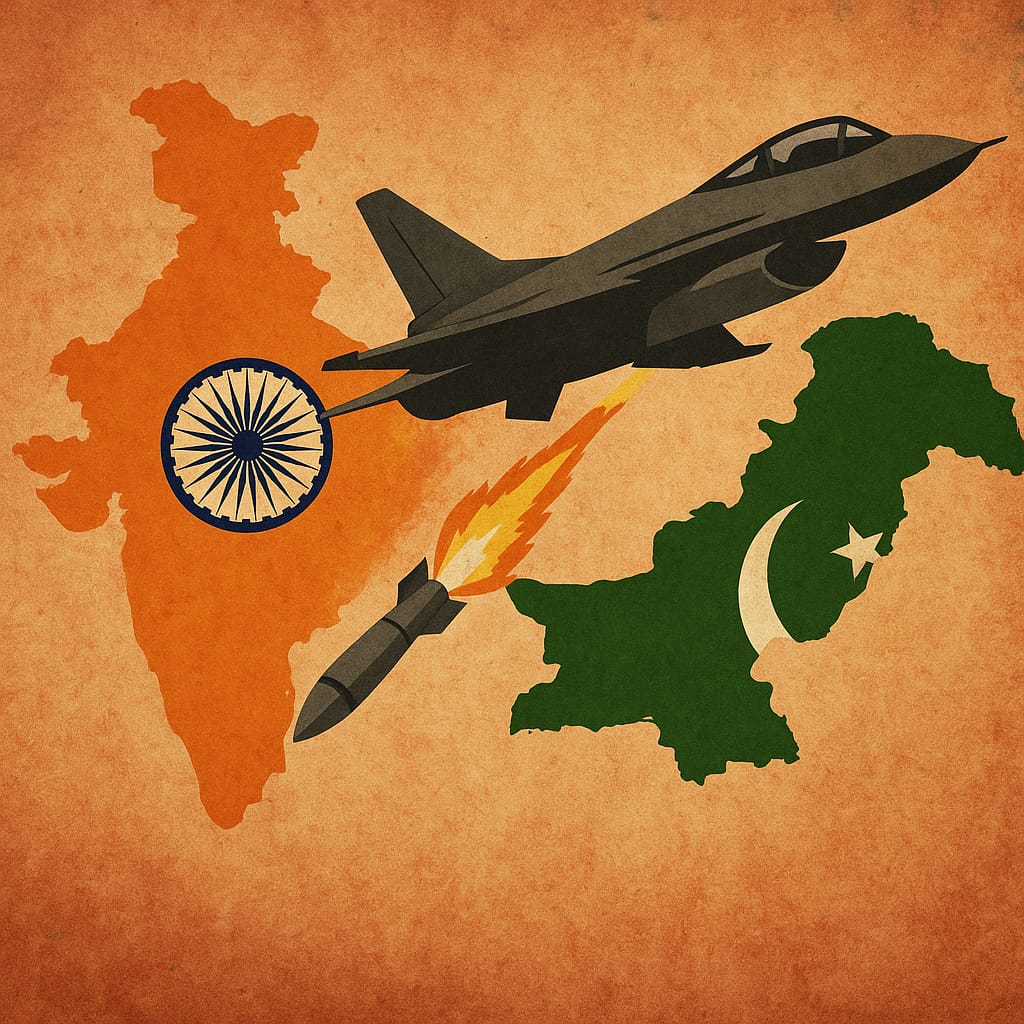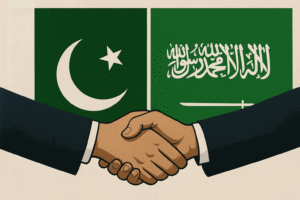Preemption or Provocation?

A conceptual illustration highlighting the escalating military tensions between India and Pakistan, focusing on the themes of preemption, provocation, and regional security risks.
On April 22, four terrorists opened fire on tourists in Pahalgam, in the Indian Illegally Occupied Jammu and Kashmir (IIOJ&K), resulting in 26 deaths and multiple injuries. The Indian government, much of the Indian media, and a large number of the country’s content creators quickly jumped to the conclusion that Pakistan was behind the attack. However, they have yet to present any evidence to support this claim, relying instead on the naïve justification that, since a group, already banned in Pakistan, is allegedly behind the incident and has not, in their view, been brought to justice, this establishes Pakistan’s complicity.
Happymon Jacob, an Indian columnist, echoes a similar narrative in his Hindustan Times article titled “The Many Messages in Operation Sindoor,” ironically blaming Pakistan for being attacked. This article is a rebuttal to his claims.
The justification to attack Pakistan is so naïve that one can hardly take it seriously. If such logic were accepted, then by the same standard, there are also groups or individuals in India that support terrorism in Pakistan. For that matter, despite substantial evidence linking Modi to the 2002 Gujarat riots, he becomes the Prime Minister, does that mean the Indian state supports the massacre of Muslims?
Those making such claims need to understand that this is not how international law or diplomacy functions. Country ‘A’ cannot ask Country ‘B’ to take action against certain groups or individuals within its territory based solely on suspicion or historical grievances; concrete evidence is required for any legitimate response. Otherwise, without credible proof, any country could blame foreign groups for incidents and demand action, undermining international law and accountability.
New Delhi, under this naïve justification, started a false flag operation titled Operation Sindoor. The Indian narrative of Operation Sindoor emphasizes a strategic shift from “restraint” to “resolve.” However, such measures need to be critically analyzed in light of international law, regional stability, and historical context.
Firstly, the Modi regime’s ‘mad-venture’ against Pakistan is a clear violation of Pakistan’s territorial sovereignty, violating the UN Charter (Article 2(4)). The article clearly prohibits the use of force against the political independence and territorial integrity of a state. New Delhi undertook a similar action in 2019, known as the Balakot Strikes. It has not been able to prove in this or the previous case that there is a clear, direct, and immediate threat, which is necessary for the UN Charter’s Article 51 concept of self-defense.
Moreover, according to international law specialists such as Mary Ellen O’Connell, the concept of preemptive self-defense lacks legal justification unless there is clear evidence of an imminent and overwhelming threat. New Delhi’s claim of self-defense is implausible in international forums without credible international verification of the targets struck, whether in the recent or in previous actions by Indian forces.
Secondly, the Modi regime’s attribution of the Pahalgam attack to groups based in Pakistan, such as Lashkar-e-Taiba, while politically persuasive, does not substitute for credible, evidence-based accountability or international investigations. Recent history, as seen in the cases of the 2008 Mumbai attacks and the Pathankot incident, shows that New Delhi has not been able to translate its unilateral provision of intelligence into judicial outcomes, partly due to a lack of legally admissible evidence or judicial processes acceptable under international standards.
Pakistan has consistently and repeatedly called for joint investigations and has cooperated in multilateral counter-terrorism platforms like the UN Counter-Terrorism Executive Directorate (CTED) and the Financial Action Task Force (FATF). Pakistan was removed from the FATF’s grey list in 2022 after the organization recognized its notable success in preventing the financing of terrorism and prosecuting terrorists identified by the UN since 2018. This development contradicts the narrative of a state actively sheltering or enabling terrorist actors with impunity.
Thirdly, there is also a growing misconception in New Delhi that Pakistan ‘bluffs’ nuclear risk. This dismissal is dangerously cavalier. The Stimson Center and Crisis Group have both warned in their respective reports that limited conventional strikes under a “cold start” or “surgical strike” framework could escalate uncontrollably in a politically charged environment,
Even if India and Pakistan do not explicitly reference nuclear weapons, the very existence of these weapons exerts a silent influence on the decision-making on both sides. AD National Command Authority, Pakistan, Lt Gen Khalid Ahmed Kidwai, has repeatedly stated that Pakistan’s nuclear posture is defensive, it aims to deter external aggression (not enable proxy warfare), and officially, Pakistan does not subscribe to a No-First Use (NFU) Policy.
The risk of false alarms and miscalculation, as seen in the current India-Pakistan escalation following the false flag operation by the BJP regime, during which Indian MiG-29 and Rafale jets, along with dozens of (Israeli) drones, were shot down, remains high. Downplaying these risks undermines the fragile deterrence equilibrium in South Asia.
Fourthly, India’s military adventurism in 2019 and the recent case, under the false pretext of preemption, risks derailing the nascent peace processes and diminishing the chances of dialogue between the two nuclear-armed rivals, continuously endangering both regional and global peace. The Modi regime, in its efforts to appease Hindutva ideologues, save face amid repeated failures to protect its own citizens, and possibly for reasons not publicly known, has taken unilateral military actions that risk plunging the region back into instability.
Furthermore, it was India, not Pakistan, that initially took the issue of Kashmir to the United Nations, and it is now India that disregards the UN resolutions on the matter. International bodies and agencies, such as the UN Office of the High Commissioner for Human Rights (OHCHR) and the European Parliament, have raised concerns about the legal and humanitarian implications of Indian policies in IIOJ&K since the revocation of Article 370 in August 2019. Without addressing the underlying political issues, any unilateral militaristic action in this sensitive region risks further alienating the local populace and complicating India’s own counterinsurgency efforts.
In sum, India’s unilateral military actions under Operation Sindoor lack legal and evidentiary justification, undermine international norms, and heighten regional instability. Without credible proof or dialogue, such actions risk escalating tensions with Pakistan, eroding global trust, and jeopardizing prospects for peace in a volatile South Asian landscape where one nuclear-armed country maintains rivalries with two nuclear neighbors.



